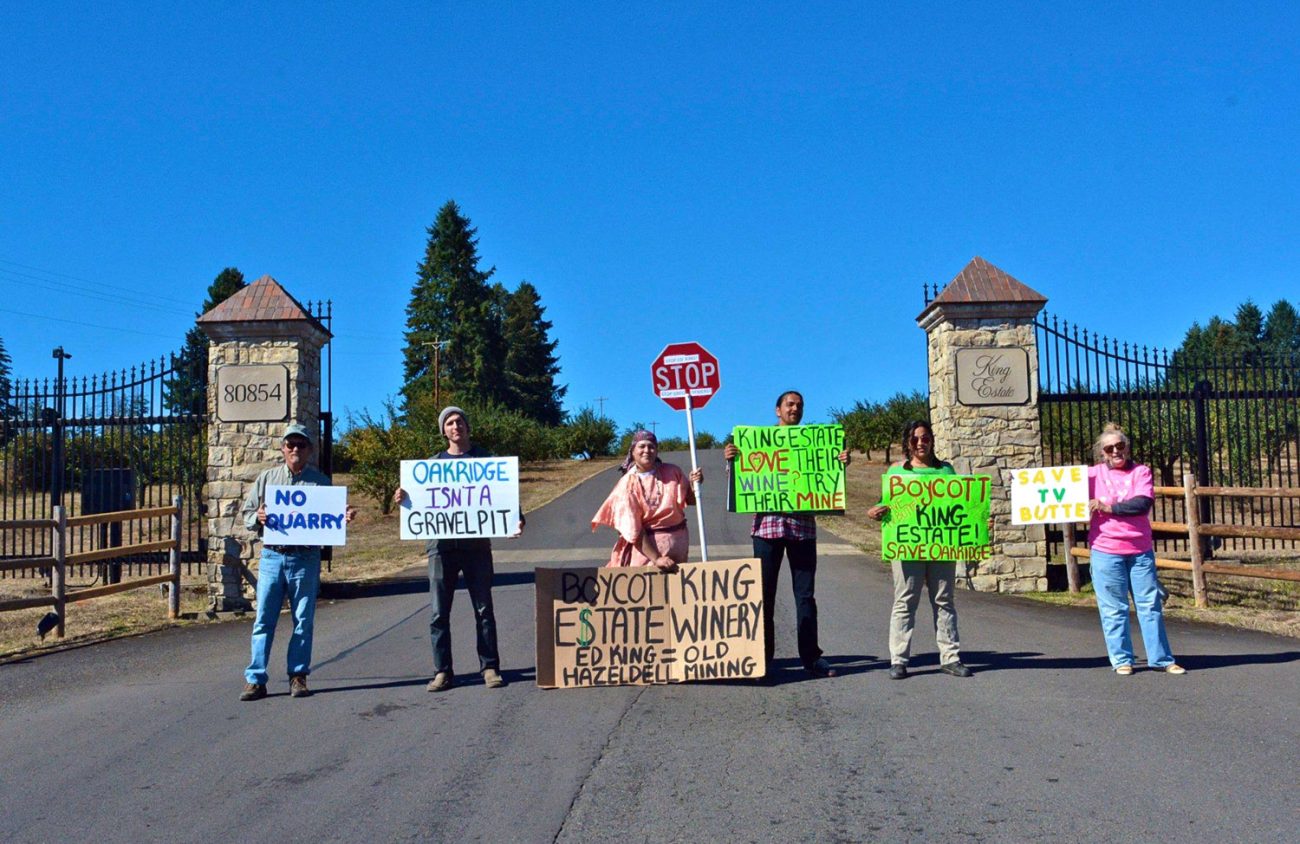A grassroots group of citizens and land use advocates continues to fight a quarry planned for a butte just on the edges of Oakridge. Save TV Butte is up against Ed King of King Estate Winery, who is an investor in the Old Hazeldell Quarry project.
Save TV Butte and one of its members, Kathy Pokorny, have filed a petition for review with Oregon’s Land Use Board of Appeals.
The group says its petition is a “legal challenge to Lane County’s rubber-stamp approval of the dangerous, disfiguring gravel strip-mine.”
While opposition to the Old Hazeldell Quarry stems from environmental and livability concerns, the LUBA case itself addresses what mine opponent Kevin Matthews calls a “complicated multipart land-use decision involving rezoning the land and several things changing at once,” such as changing Lane County’s Rural Comprehensive Plan (RCP) and adding the mine to the natural resources inventory.
Pokorny, a retiree, is new to battles such as this. “I’ve always been involved in community activities and community groups, but this is the first time I’ve ever stepped forward and tried to lead the charge,” she says.
The butte, she says, is “right here in our front yard,” and she’s concerned about the health aspects both personally and for the people of Oakridge. “In our research we discovered that silica dust is right close to asbestos as far as health risks.” The silica comes from the blasting and grinding of andesite rock in the quarry, Pokorny says.
Old Hazeldell spokesman Phil Donavan says, “There were no surprises in the appeal. The Lane [County] Board of Commissioners generally rejected these same arguments based on their staff analysis and the evidence available.”
He continues, “We’re confident LUBA will rule before Christmas, and we can get to work creating jobs in and around Oakridge.”
The quarry’s website says it seeks to be a good neighbor, and the quarry proponents designed the location so that “… we do not impact water or air quality.” The website goes on, “We will create a screen using natural rock and trees from preparing the site.”
In March the Lane County Commission approved the changes to the county’s RCP, adding the Hazeldell site to the Lane County Inventory of Significant Mineral and Aggregate Sites. The vote also authorized mining and processing and amended the RCP to re-designate land from forest to natural resource mineral, and rezoned that land from non-impacted forestland and impacted forestland to quarry and mine operations.
In other words, TV Butte moved from being forestland to being zoned for a hard rock quarry — a place where “big rocks,” as the mine says on its website FAQ, “are turned into smaller ones.”
Mining and natural resources fall under Oregon’s Statewide Planning Goals and Guidelines.
Goal 5 of those planning goals covers more than a dozen resources, including wildlife habitats, historic places and aggregate, aka gravel, according to the Oregon Department of Land Conservation and Development. The goal lumps together natural resources to be preserved, such as waterways and wildlife habitats, with natural resources to be exploited, such as gravel.
Matthews, a land use advocate and Lane County Commission candidate, has been assisting Save TV Butte in its efforts. He says that while the group’s concerns stem from increased traffic, effects on wildlife, “obvious landslide risks” and potential damage to local streams as well as a history of use of the area by local Native American tribes, the LUBA case centers on the regulatory process.
There is an “underlying inequity in the system” Matthews says. Under Goal 5, the environmental resources were all supposed to be inventoried at the beginning of the land use planning system and “there’s not really any concrete mechanism to go back and add natural resources.”
So while a section of land may be elk habitat, if it was not inventoried under Goal 5 as such, it won’t be added later. However, there is a “complicated flow chart,” Matthews says, that allows a gravel mine to be added to the Goal 5 inventory.
“When you go through that flow chart, 99 times out of 100 it ends in the local government having to acknowledge the gravel resource,” he says. One posible way to escape it is if there’s a conflict between gravel resources and other inventoried resources like wildlife habitat.
But, Matthews says, “Lane County has virtually no land in its wildlife habitat inventory. So they sort of set up a Catch-22 in that there’s no given process for adding environmental resources. Just gravel.”
Lane County Public Information Officer Devon Ashbridge says of Save TV Butte’s petition, “We pay close attention to LUBA decisions, including the Hazeldell appeal, and evaluate those decisions to determine what effect they may have on future decision making.”
Matthews says Save TV Butte faces a few challenges: not only understanding the complicated land use process in order to be able to fight the mine, but also fundraising to hire an attorney.
“Raising funds has been really iffy,” Pokorny says, “but luckily some folks have stepped forward and helped us out.” Save TV Butte is mainly “retired folks who live on Social Security,” she adds.
The group represented itself through the county process, but has now hired attorney Zack Mittge of Hutchinson Cox to represent them before LUBA.
Fundraising involves making “a bazillion phone calls” and having a presence at local festivals and events, Pokorny says. Save TV Butte will participate in and wants to fundraise at the upcoming Oakridge Sugarplum Festival that is held each year in early December.
To find out more about Old Hazeldell’s plans go to old-hazeldell.squarespace.com and to support Save TV Butte go to facebook.com/savetvbutte.
